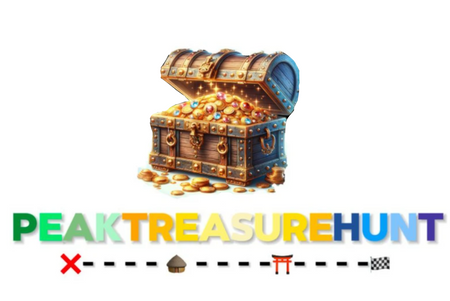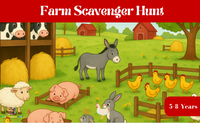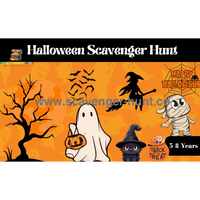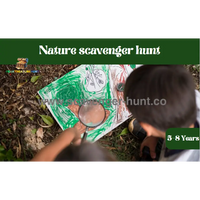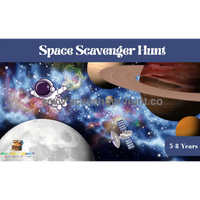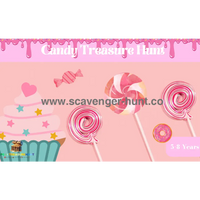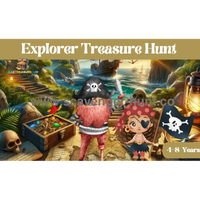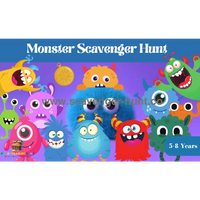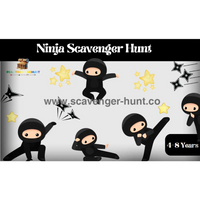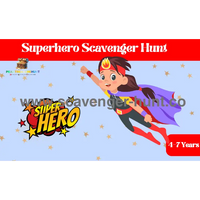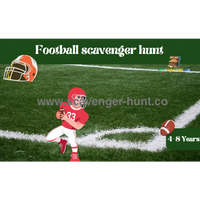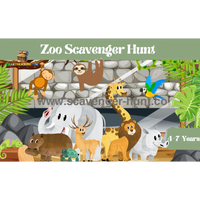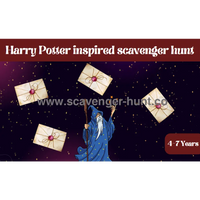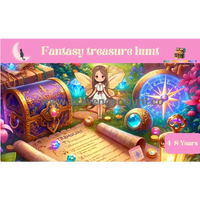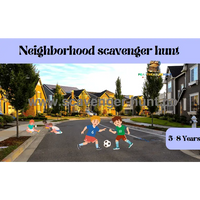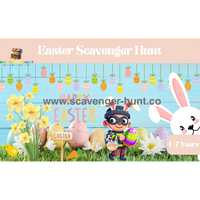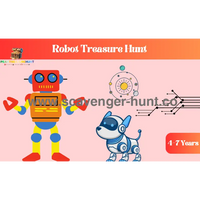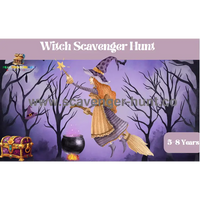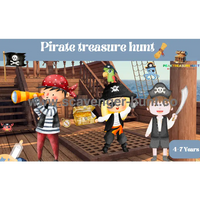🙌Ultimate Guide: Creating Magical Birthday Treasure Hunts Your Kids Will Never Forget
Creating the Perfect Birthday Treasure Hunt: A Parent's Complete Guide
Introduction
Planning a child's birthday party can be both exciting and challenging. Among all party activities, a treasure hunt stands out as an adventure that creates lasting memories. This guide will help you organize an unforgettable birthday treasure hunt that's age-appropriate and entertaining. Whether you're planning for preschoolers or pre-teens, we'll walk you through everything from setting up clues to ensuring safety. According to recent surveys, 78% of children rate treasure hunts as their favorite birthday party activity, making it a foolproof choice for your next celebration.
1: Planning Your Birthday Treasure Hunt
Age-Appropriate Adventures
- Ages 4-6: Simple picture clues and short distances
- Ages 7-9: Basic written clues with rhymes
- Ages 10-12: More complex riddles and multi-step challenges
Remember to keep groups small - research shows 4-6 kids per team works best for maintaining engagement and preventing chaos.
Essential Materials
- Clue cards (waterproof if outdoors)
- Small prizes along the way
- Main treasure chest
- Safety equipment (flashlights for indoor hunts)
- Decorative maps
There’s something magical about treasure hunts that sparks curiosity, excitement, and adventure in people of all ages. So, imagine turning your birthday party into an unforgettable quest where every clue leads to a surprise, and the ultimate goal is a hidden treasure. Whether you're planning this for yourself, your child, or even a group of friends, a birthday treasure hunt guarantees fun, laughter, and maybe a few happy tears! Ready to plan the most epic birthday treasure hunt ever? Let’s dive in.
Step 1: Decide on a Theme 🎨
The theme of your treasure hunt sets the tone for the entire experience. Do you want something pirate-themed with “Arrr matey” at every turn? Maybe a magical quest where participants need to solve mystical riddles? Here are some popular treasure hunt themes to get your ideas flowing:
-
Pirate Adventure 🏴☠️: Complete with treasure maps, eye patches, and hidden gold!
-
Magical Kingdom 🏰: Unicorns, fairies, and wizards leaving behind glittering clues.
-
Superhero Quest 🦸: Save the city by finding clues that lead to the villain’s hideout.
-
Space Odyssey 🚀: Travel from planet to planet (room to room) collecting cosmic tokens.
Choose something that excites the birthday person. If it’s for a group, pick a theme that will resonate with all the participants.
Step 2: Know Your Space 📍
Next, figure out where you’re going to hold your treasure hunt. This can vary based on the size of your party and the theme you’ve chosen. You could use:
-
Indoor Spaces: Perfect for smaller gatherings or if the weather isn’t cooperating. You can hide clues in drawers, under furniture, or even inside books.
-
Outdoor Spaces: Parks, backyards, or even the beach offer more room to run and explore. If you have access to a large garden or a park, the possibilities are endless.
-
Public Spaces (with caution!): Museums, shopping malls, or city landmarks can add a unique twist. Just make sure you get permission and are mindful of the crowd.
Remember to walk through your chosen area in advance to make sure you have enough hiding spots and that it’s safe for all participants, especially kids!
Step 3: Create the Clues 📝🔍
Now, the fun part begins! Writing clues can be as simple or as complex as you want, depending on the age group and the difficulty level you’re aiming for. For kids, you might want to keep it light and easy, like:
- “I have hands but can’t clap. What am I?” (Answer: A clock 🕰️)
- “I’m where you rest your head, under the blankets where dreams are fed.” (Answer: A bed 🛏️)
For older kids or adults, ramp up the challenge with riddles, codes, or even puzzles. You could use:
-
Riddles: “I speak without a mouth and hear without ears. What am I?” (Answer: An echo).
-
Codes: You can use basic ciphers or hidden messages that require decoding.
-
Photos: For younger children, printing pictures of hiding spots can make it easier to follow along.
Pro Tip: Keep the clues connected to your theme for extra immersion. For a pirate theme, clues can be written on old-looking parchment with burnt edges, while a space-themed hunt might have digital-looking codes or constellation maps.
Step 4: Organize the Flow 🚦
To keep your treasure hunt exciting, pace it out! Start with easier clues and gradually make them more challenging. Balance the difficulty with a mix of action (running around) and thinking (solving puzzles).
If you’re working with teams, make sure everyone gets a turn to solve a clue. Consider adding little checkpoints or mini-games along the way, where they need to complete a task to get the next clue. For example:
-
Pirate theme: They might need to walk the plank (a piece of wood over some pillows).
-
Superhero theme: They might have to use their "superpowers" to jump through an obstacle course.
You can also have different routes for different teams, ensuring that they don’t all arrive at the treasure at the same time. But make sure every path is fair and equally fun!
Step 5: Hide the Treasure 🎁
Ah, the grand finale! The treasure doesn’t have to be anything over the top, but it should be rewarding. A chest full of chocolate coins, small toys, or even personalized birthday favors can work. For adults, you could get creative and hide a gift card, a bottle of wine, or a handwritten note promising a special experience.
The key is to make it feel special. You could decorate the final treasure spot to give it a magical reveal. Add balloons, confetti, or a treasure map marking “X” that leads to the big prize. The more dramatic the unveiling, the better!
Step 6: Set the Rules 📜
While treasure hunts are meant to be spontaneous and fun, setting a few ground rules can prevent chaos:
-
Time Limits: Keep things on track by setting a time limit for each clue or the whole hunt.
-
Boundaries: Define the playing area so no one wanders too far.
-
Hint System: If players get stuck on a clue for too long, have a hint system in place to keep things moving.
-
Teamwork: If it’s a team-based hunt, encourage working together. No one likes a bossy treasure hunter! 🧐
Step 7: Have Fun and Enjoy the Day! 🎈
Finally, the most important part: have fun! It’s easy to get caught up in making sure everything goes perfectly, but treasure hunts are about creating joyful, playful memories. Whether it’s seeing the wide-eyed excitement of kids or hearing adults laugh at their own missed clues, the joy is in the journey.
Make sure someone is taking photos or videos (maybe even set up a GoPro for the final treasure reveal!) so you can relive the excitement later. And remember, if something doesn’t go as planned, just roll with it. Sometimes, the unexpected moments make for the best memories.
A birthday treasure hunt is more than just a game. It’s an adventure that brings people together, taps into creativity, and offers a sense of accomplishment for everyone involved. So go ahead, channel your inner pirate, wizard, or superhero, and create a birthday to remember. 🎉👑
2: Creating Engaging Treasure Hunt Clues
Clue Types by Age Group
- Picture-based: "Find the next clue under something that looks like this 🌳"
- Word-based: "I'm wet and wild, with water so blue, look near the pool for your next clue"
- Math challenges: "Add your age to 5, then walk that many steps east"
Pro tip: Always make backup copies of clues - kids can sometimes accidentally damage or lose them in their excitement!
One of the most exciting parts of any treasure hunt is solving the clues. They’re what turn an ordinary game into an adventure filled with curiosity and suspense. The perfect clue keeps participants thinking, laughing, and racing to find the next spot. But how do you craft those clues? Whether you want to make them easy for younger kids or challenging for older players, I've got you covered. Ready to get creative? Let’s dive into how you can make your treasure hunt clues engaging and fun!
Step 1: Know Your Audience 🎯
The first thing to consider when creating clues is who will be solving them. Are you designing this treasure hunt for young children, teenagers, or adults? The difficulty and style of your clues should match the participants’ abilities and interests.
-
For kids: Keep the clues simple and visual. Rhymes, easy riddles, or picture-based hints work best.
-
For teens: You can make the clues more challenging by incorporating word puzzles, math problems, or even pop culture references.
-
For adults: Feel free to get creative with wordplay, codes, or more complex riddles. A little intellectual challenge can make the game even more satisfying!
Also, consider the energy level of your group. Younger kids will need fast-paced action, while older players might appreciate the mental puzzle as much as the physical hunt.
Step 2: Mix Up the Types of Clues 🔄
Variety is key to keeping the hunt exciting. If every clue feels the same, the energy can dip. So let’s look at a few different types of clues you can mix and match to keep things fresh:
-
Riddles 🧠 Riddles are classic treasure hunt material. They challenge players to think creatively. Keep the difficulty level balanced — challenging enough to make them think, but not so hard they get frustrated.
-
Example for kids: “I have keys but no locks. I have space but no room. You can enter, but you can't go outside. What am I?” (Answer: A keyboard ⌨️)
-
Example for adults: “The more you take, the more you leave behind. What am I?” (Answer: Footsteps 👣)
-
Rhymes 🎶 Rhyming clues are fun and flow naturally, especially for younger kids. You can also make them a bit silly or playful to add some humor.
- Example: “Up the stairs and through the hall, look for a room with the biggest ball!” (This could lead to a bedroom with a beach ball or soccer ball.)
-
Puzzles 🧩 Puzzles can be word-based, visual, or even physical. These work well for older children and adults. You could create simple jigsaw puzzles where the completed picture gives them a hint about the next location.
- Example: Print a picture of the next hiding spot, cut it into a puzzle, and have the players assemble it.
-
Picture Clues 📸 Younger children who can’t read yet or who are just learning to read will love visual clues. Take pictures of specific locations where the next clue is hidden. You can even zoom in on an object to make it trickier.
- Example: A close-up of a doorknob or a tree trunk can be a great challenge for kids to figure out.
-
Physical Tasks 💪 Not all clues have to be written. You can incorporate small tasks that the players need to complete before they get the next clue. It adds a bit of action and can be a fun change of pace.
- Example: “Do 10 jumping jacks to receive your next clue.” Or “Balance a book on your head while walking across the room.”
-
Codes and Ciphers 🔑 For older players or adults, ciphers and codes add a layer of mystery. You can use simple ciphers like Caesar shifts or more complex ones like Morse code. Players will need to crack the code to reveal their next hint.
- Example: Write a message where each letter is replaced by the one that comes after it in the alphabet (A becomes B, B becomes C, etc.). “Efgfoe uif bmsm!” becomes “Defend the arm!”
Step 3: Tie the Clues to the Theme 🌟
One of the easiest ways to make your treasure hunt feel cohesive and engaging is to tie every clue back to your overall theme. If you're doing a pirate-themed hunt, make sure your clues sound like they’re coming from a pirate. If it’s a fairy-tale theme, maybe the clues rhyme like a magical spell.
Here are some theme-based examples:
-
Pirate Theme 🏴☠️: “Yo-ho-ho! Ye next clue be hidden where ye clean yer paws. Look sharp, or ye’ll be swabbin’ the floors!” (Answer: The bathroom sink 🧼)
-
Spy Theme 🕵️♂️: “Agent 007, your mission is clear. Look under the chair, but beware—someone might be near!” (Answer: Under a chair, naturally.)
-
Fairy-Tale Theme 🧚♀️: “A mirror on the wall holds the clue you seek. But only the fairest shall take a peek.” (Answer: A mirror in the house.)
Staying consistent with your theme makes the hunt feel more immersive, and the clues will naturally feel like part of the story.
Step 4: Don’t Make It Too Hard (or Too Easy) 🎯
Balance is key when it comes to writing clues. You want players to feel challenged, but not stuck. If the clues are too hard, frustration sets in, and the fun is lost. On the other hand, if the clues are too easy, the hunt feels flat and over too quickly.
A good rule of thumb: test your clues on someone else before the big day! See how long it takes them to solve it. If they struggle for more than a few minutes without making progress, it might need tweaking. You can also include hints along the way to keep things moving.
Pro Tip: For young children, if you see they’re struggling, have a “helping hand” system in place. Maybe there’s a side character (like a stuffed animal or a toy) that gives them a little nudge in the right direction if needed.
Step 5: The Final Clue & The Big Reveal 🎁
The final clue is the moment everyone has been working toward, so make sure it feels epic. This is where the excitement peaks. You might want to make the last clue a little more challenging to add suspense, or make it an action-packed finish.
- Example: For a pirate hunt, the final clue could lead them to an “X” marked on the ground where they have to dig for treasure (you could fill a box with gold-wrapped chocolates and toys).
- Example: For a superhero hunt, the final clue might lead them to “defuse a bomb” (which could just be a piñata filled with candy and prizes).
Make sure the final reward feels worth the adventure! Even if it’s something small, the presentation and excitement of finally “discovering the treasure” is what really counts.
Step 6: Have Fun Watching the Hunt Unfold! 🎉
Once your clues are written and the treasure is hidden, all that’s left to do is sit back and watch the adventure unfold! There’s nothing quite like seeing people’s faces light up when they solve a tricky riddle or the excitement as they race to the next spot.
If you’ve balanced creativity, challenge, and fun, then you’ve nailed it. Watching everyone work together (or get a little competitive!) is what makes treasure hunts such a blast.
Creating engaging treasure hunt clues is all about creativity and knowing your audience. Whether you’re crafting playful rhymes for kids or complex puzzles for adults, the key is making the journey just as exciting as the final treasure. So, get writing, have fun, and get ready for an unforgettable adventure! 🌟🗺️
3: Setting Up Your Birthday Party Treasure Hunt Route
Location Options
- Indoor routes (perfect for bad weather)
- Backyard adventures
- Neighborhood scavenger hunts (with proper supervision)
- Combined indoor/outdoor experiences
Safety statistics show that having one adult supervisor per 4-5 children is ideal for neighborhood hunts.
You’ve got the theme picked out, the clues ready, and the excitement building. Now it’s time for the heart of your treasure hunt: setting up the route. This is where your clues come to life, guiding the treasure hunters from one location to the next. But how do you create a route that’s fun, logical, and keeps everyone on their toes? Let’s walk through how to set up the perfect treasure hunt route for your birthday party!
Step 1: Plan the Starting Point 🎬
The very first clue should get everyone excited and ready to go! You want it to be easy to find and set the tone for the adventure ahead. Think of it like the spark that lights the fire.
-
For kids: Start the hunt with something visual or obvious, like a big envelope with the first clue or a brightly colored balloon marking the spot. You want the little ones to feel excited, not overwhelmed, right from the start.
-
For older players or adults: You can add a bit more mystery to the beginning. Maybe they have to solve a quick riddle or find the first clue hidden under something like a chair or behind a painting.
Pro Tip: Make sure the starting point is easy to gather around so you can explain the rules and get everyone on the same page before the hunt kicks off.
Step 2: Map Out the Route 🗺️
Before you hide anything, walk through the space where your treasure hunt will take place—whether it’s your house, backyard, or a park. You need to make sure the route flows smoothly and makes sense. A few things to keep in mind:
-
Safety first: Especially if you’re working with kids, make sure there are no dangerous spots like staircases without railings or sharp objects nearby.
-
Distance: Keep your players moving, but don’t make the clues so far apart that people get tired or lose interest. You want just enough of a journey between clues to build excitement!
-
Accessibility: Make sure every player can access the clues. If you’re working with mixed ages or abilities, avoid hiding clues in places that are too high or tricky to reach.
Think about the locations you’re going to use and how they flow together. Are they in logical places? You don’t want participants running back and forth across a massive space without a purpose—that’ll only lead to frustration.
Step 3: Hide the Clues 🔍
Now for the fun part: hiding the clues! Here’s where you get to put your creativity into action. Depending on your theme and the age group, you can make this process as simple or tricky as you want. Here are some tips for hiding clues:
-
Make them visible (for younger kids): Little ones might not have the patience for an extended search. Place clues in places where they’re likely to spot them, like under a pillow, taped to a wall, or on top of a table.
-
Be sneaky (for older kids and adults): If your group is a bit older, get creative. Tuck clues inside books, tape them under chairs, hide them behind picture frames, or even fold them into origami shapes for an extra challenge!
-
Stick to the theme: If your theme is pirate-related, roll the clues up like ancient scrolls and hide them in bottles. For a spy theme, maybe the clues are hidden in secret compartments or inside “briefcases” (aka, an old lunchbox or suitcase).
Pro Tip: If you’re worried that players might miss a clue, you can leave little hints along the way—like an arrow pointing to where they should look—or have a backup clue ready in case they get really stuck.
Step 4: Consider the Route Flow 🚦
The flow of your treasure hunt should build anticipation as players get closer to the final treasure. Here's how to keep things moving smoothly:
-
Mix it up: Alternate between easy and challenging clues. If one clue is particularly tough, make the next one simpler to keep the momentum going.
-
Add in physical activity: If you’ve got an energetic group, make sure they’re doing more than just walking from one spot to another. You can create mini-obstacle courses, have them jump over things, or do a little scavenger hunt within the hunt to keep them engaged.
-
Break it up into stages: If your hunt covers a large space, you can have “checkpoints” where the teams or individuals stop for a quick game, puzzle, or task before moving on. This is a great way to add variety and keep the hunt from feeling too linear.
-
Time limits: If you’re working with older kids or adults, introducing a timer or stopwatch can add an element of excitement and urgency. Maybe they only have 3 minutes to solve each clue before they miss out on a bonus reward!
Step 5: Plan the Big Finale 🎁🎊
The final location should feel like a grand reveal. After all, this is where the treasure is hidden! Make it special and memorable—whether it’s the treasure itself, how it’s hidden, or the atmosphere of the spot.
-
Make it dramatic: You can have a treasure chest buried under a pile of leaves (or balloons if you’re indoors), or a “vault” (an old box wrapped up in shiny paper) that needs a special key to open. It’s the little touches that make it exciting!
-
Group celebrations: If you have a large group, make sure the final clue leads to a space where everyone can gather for the big reveal. You don’t want it to be a cramped or awkward ending.
-
The treasure: The treasure doesn’t have to be extravagant—it could be anything from chocolate coins to personalized gifts to a piñata filled with candy. The real fun is in the journey, but the ending should still feel like a victory!
Pro Tip: Add a fun twist to the final clue! Maybe they have to answer one last riddle, complete a quick challenge, or even solve a small puzzle to unlock the treasure.
Step 6: Test Run the Route 🏃♂️💨
Before the big day, it’s a good idea to do a test run of your treasure hunt. Walk through the entire route, following the clues exactly as your participants will. This way, you can spot any potential issues, like:
-
Clues being too easy to spot (or too hard to find).
-
Locations being too far apart or areas where players might get confused about which direction to head.
-
Unexpected obstacles: You never know—something might change the day of the party (like a room being locked, or weather issues if you’re outdoors), so it’s good to have a backup plan.
Testing also helps you gauge the timing. You’ll get a sense of whether the hunt will be too short or too long and can make adjustments accordingly.
Step 7: Add Some Fun Extras 🎈
To really take your treasure hunt to the next level, think about adding some extra fun details along the way.
-
Costumes: If your theme allows it, encourage players to dress up! Pirates, superheroes, detectives—it adds to the excitement and makes everyone feel like they’re truly part of the adventure.
-
Props: If you have time, make or buy a few props to hide with the clues. Maybe a pirate map, a magnifying glass for a detective hunt, or even a "magic wand" for a fairy-themed treasure hunt.
-
Prizes along the way: Instead of just having one final treasure, you can hide small rewards at different stops along the route. Little trinkets, candies, or funny notes make for nice surprises to keep everyone motivated!
Step 8: Enjoy the Adventure! 🎉💥
Once everything’s set, all that’s left to do is enjoy watching everyone have a blast! Treasure hunts are as much about the adventure as they are about the treasure itself. Watching the participants run around, laugh, and work together will be just as rewarding as the big reveal at the end.
And remember: not everything will go perfectly—and that’s okay! The joy of a treasure hunt is in the unexpected moments, the teamwork, and the fun of figuring things out along the way. So relax, join in on the fun if you can, and celebrate the success of an epic birthday party treasure hunt!
Setting up a birthday party treasure hunt route doesn’t have to be stressful. With a little planning, creativity, and a sense of adventure, you can create an experience that everyone will remember for years to come. So go ahead—design your route, hide those clues, and get ready for a birthday bash full of excitement, laughter, and, of course, treasure! 🎉🎁🌟
4: Incorporating Special Treasure Hunt Elements
Theme Ideas
- Pirate adventure
- Fairy tale quest
- Superhero mission
- Space exploration
- Dinosaur dig
A 2023 survey indicates that pirate themes remain the most popular, chosen by 45% of parents organizing birthday treasure hunts.
So, you’ve got your treasure hunt planned and the clues ready to go, but you want to make it extra special. How can you add unique elements to take your treasure hunt from fun to unforgettable? Well, this is where the magic happens. Incorporating special elements—whether it’s cool gadgets, personal touches, or creative challenges—can turn an ordinary hunt into an extraordinary adventure.
Let’s dive into some fun ideas that will make your treasure hunt stand out and keep your players talking about it long after the party’s over.
Step 1: Personalized Clues and Messages ✍️💌
One way to make the treasure hunt feel extra special is by personalizing the clues. Instead of generic hints, you can tailor them to the players’ personalities, interests, or inside jokes.
-
For kids: Use their favorite characters, hobbies, or school subjects. If one of the participants loves dinosaurs, make a clue that references a T-Rex or hiding a clue in a “prehistoric egg” (an old Easter egg painted to look like a fossil).
-
For adults: Incorporate shared memories or inside jokes into the clues. Maybe one clue leads to the spot where the birthday person always loses their keys or where the group shared a memorable moment.
You could even write the clues in different formats: letters, poems, or even from a mysterious “character” (like a pirate, spy, or wizard) who’s leading the hunt. Imagine how excited someone will be to get a riddle written just for them!
Pro Tip: If your hunt includes multiple people, write a special message or note for each participant at the end of the hunt. It’s a small, thoughtful detail that will make everyone feel appreciated.
Step 2: Incorporate Gadgets and Technology 📱🔦
Adding a bit of tech can really level up your treasure hunt, especially if you’ve got older kids, teens, or adults participating. You can use gadgets to create cool moments of surprise or enhance the mystery.
-
QR Codes: Hide QR codes at certain clue locations. When scanned with a smartphone, these codes can lead to the next clue, a fun video message, or even a secret website you’ve made for the hunt!
-
Walkie-Talkies: For an adventurous feel, give players walkie-talkies to communicate during the hunt. If they get stuck, you can “radio in” with hints like you’re a guide helping them from a secret base.
-
Flashlights: If your treasure hunt takes place in a dim or nighttime setting, incorporate flashlights for a mysterious feel. Imagine them finding a clue only after shining their light in just the right spot—like on a hidden code written in invisible ink!
-
Geocaching: If your treasure hunt is outdoors and your participants are tech-savvy, you could use GPS or a geocaching app to lead them to specific coordinates. It’s like adding a real-world scavenger hunt element to your game.
Step 3: Create Interactive Challenges 💪🤹♂️
A treasure hunt doesn’t have to be all about finding clues. Why not throw in some fun challenges along the way? These can add excitement, humor, and team-building to your hunt.
-
Physical Challenges: Include tasks that get players moving, like “hop on one foot for 10 seconds to unlock the next clue” or “complete an obstacle course before you can move on.” If your hunt is outdoors, you can even have players search for natural items like leaves or rocks that they need to bring back to a central point.
-
Puzzles and Brain Teasers: Add a mental challenge with puzzles that need to be solved before moving on. Jigsaw puzzles, crossword puzzles, or Sudoku could fit the theme of your hunt. For older kids or adults, you could create a lockbox that can only be opened by solving a tricky riddle or code.
-
Mini Games: Break up the clue-solving by having participants complete mini-games before they get their next hint. For example, you could include a quick round of “Simon Says,” “charades,” or even a trivia question related to the theme of the hunt.
These interactive elements make the treasure hunt feel more dynamic and give participants a chance to showcase different skills—not just puzzle-solving.
Step 4: Add Themed Props and Costumes 🎭👑
Immersing your players in the theme of the hunt can make it feel more like an adventure and less like a simple game. Props and costumes are a great way to bring the theme to life!
-
Props: Depending on your theme, you could incorporate props that the players use or find along the way. For example, in a pirate-themed hunt, you could hide a “treasure map” or a plastic sword at one of the locations. For a detective-themed hunt, maybe they need to find a magnifying glass or a “confidential” envelope filled with clues.
-
Costumes: Encourage players to dress up to match the theme of the hunt. Pirates, knights, astronauts, or detectives—costumes will make everyone feel like they’re part of the story. Even something as simple as themed hats or masks can add a lot to the atmosphere.
-
Role-Playing: If you really want to go all out, you can have a designated “game master” (you or another helper) stay in character throughout the hunt. Maybe you’re the captain of the pirate ship giving orders, or a wizard guiding them through a magical land.
Pro Tip: Give each player a special prop or token that helps them solve a final challenge or unlock the treasure. Maybe they need to collect three “magic keys” throughout the hunt to open the final chest!
Step 5: Use Codes and Hidden Messages 🔐📝
For an extra level of intrigue, incorporate secret codes and hidden messages into your treasure hunt. They’ll give your players a satisfying “aha!” moment when they crack the code and reveal the next clue.
-
Ciphers: You can use classic ciphers like the Caesar cipher (where each letter is shifted a certain number of places in the alphabet) or the pigpen cipher (where letters are represented by symbols). You could also create your own secret code that the players need to figure out.
-
Invisible Ink: Write some of your clues using invisible ink (which you can easily make with lemon juice or a special pen) and have players use a flashlight or UV light to reveal the hidden message.
-
Scrambled Letters: Give players a word scramble that they need to solve to figure out the next location. For example, “OCFSSE” could lead them to the “OFFICE.”
Using hidden messages makes the treasure hunt feel like a secret mission and adds an element of mystery that older players will love.
Step 6: Surprise Twists and Plot Twists 🚨⚡
Who doesn’t love a good twist? Incorporating a surprise element into the treasure hunt will keep things exciting and unpredictable.
-
Double Fake Clue: Throw in a decoy clue that sends players in the wrong direction—only for them to realize they’ve been tricked (in a fun way, of course!) and need to solve another puzzle to get back on track.
-
Multiple Endings: If you have a competitive group, you could have two different “final” locations where smaller prizes are hidden, but only one holds the real treasure. The teams will need to figure out which one to go to!
-
Betrayal: For older kids or adults, add an element where one player (secretly) knows more than the others and can mislead or sabotage the group. They’ll have to figure out who’s the “traitor” before they can proceed!
-
Timed Challenges: Add an element of urgency by including certain time-based clues. For example, “You have 5 minutes to find the next location or the treasure moves!” This can ramp up the adrenaline and make the hunt more intense.
Step 7: Include Audio or Visual Elements 🎧📹
For a multisensory experience, incorporate sound or visuals into the treasure hunt. These elements can help immerse players in the atmosphere of the hunt and create some memorable moments.
-
Voice Recordings: Instead of written clues, use audio recordings of “characters” giving the next hint. You can create these yourself or use a voice app to disguise your voice for an extra mysterious touch. Imagine players hearing a pirate’s voice or a robot giving them the next riddle!
-
Videos: If you have the ability, create short videos that reveal each clue. You can even include video “challenges” where players need to act out something or answer a question before getting the next location.
-
Sound Effects: Play background music or sound effects that match the theme. For example, jungle noises for a safari-themed hunt, ocean waves for a pirate hunt, or spooky sound effects for a Halloween hunt.
Step 8: Make the Final Treasure Special 🎁💥
The treasure is the grand finale of your hunt, so make it feel like a big deal! Even if it’s something small, the presentation can make it feel extra special.
-
Treasure Chest: No matter what the theme, a treasure chest always works! You can fill it with candy, toys, or personalized gifts for each participant.
-
Piñata: For a fun, interactive ending, hide the final clue inside a piñata. Once they crack the piñata open, they’ll find their prize hidden inside!
-
Letter or Message: The final treasure could include a heartfelt letter or message to the birthday person, congratulating them on completing the hunt. It’s a simple yet meaningful way to wrap up the adventure.
By incorporating these special elements, you’ll make your treasure hunt feel like more than just a game—it’ll be an experience to remember. Whether you’re using gadgets, hidden codes, or just a bit of extra creativity, these touches will ensure your hunt is packed with excitement, surprise, and a sense of wonder.
So go ahead and add some magic to your treasure hunt, and watch as your players embark on an unforgettable adventure! 🌟🎉
5: Managing the Birthday Treasure Hunt Event
Timeline Management
- Setup: 1 hour before party
- Brief explanation: 10 minutes
- Hunt duration: 30-45 minutes
- Prize distribution: 15 minutes
Studies show that keeping the actual hunt under 45 minutes maintains optimal excitement levels.
So, you’ve spent time planning the clues, setting up the route, and incorporating special elements. Now comes the big moment—running the treasure hunt itself! Managing a birthday treasure hunt can feel like a juggling act, but with a few key strategies, you’ll make sure everything runs smoothly while keeping the fun going for everyone involved.
Let’s explore how to manage the event like a pro, while making sure the participants (and you!) enjoy every minute.
Step 1: Set the Stage Before the Hunt Begins 🎤👀
Before you set everyone loose, gather all the participants and give them a brief rundown of how the treasure hunt will work. This is a great moment to build excitement and make sure everyone’s on the same page. Here’s what you’ll want to cover:
-
Explain the rules: Keep it simple, but make sure everyone knows what to do. Explain how they’ll find clues, what they should be looking for, and any ground rules. (For example, “No running indoors” or “Don’t touch anything that’s off-limits.”)
-
Divide into teams (if needed): If you have a larger group, split everyone into teams. You can do this randomly, by age group, or even let participants pick their own teams if you want to keep things casual. Give each team a fun name or color to add to the competitive spirit!
-
Give them the first clue: Hand over the first clue to get things started. It’s a good idea to make sure this clue is clear and relatively easy, so everyone gets into the flow of the game quickly.
Pro Tip: Keep the vibe light and fun! This is a birthday party, after all. You can even introduce a themed backstory or character to make things feel more immersive. For example, if you’re running a pirate-themed hunt, speak in your best pirate accent when explaining the rules! 🏴☠️
Step 2: Be Ready for Questions and Clarifications 🤔❓
Even with clear instructions, some participants might still have questions along the way—especially younger kids or those new to treasure hunts. Here’s how you can handle those moments without breaking the flow:
-
Stay available: As the game master, keep yourself available to answer questions but try not to give away too much. Encourage participants to work together and think things through before stepping in.
-
Offer small hints: If a team or player gets stuck on a clue for too long, you can offer gentle nudges without giving away the answer. For example, you could say, “I think you should take another look at that bookshelf…” This keeps the challenge alive while preventing frustration.
-
Have a backup plan: Sometimes, players might accidentally overlook a clue or get lost (especially in a larger space). Keep a copy of the clues with you, so you can help redirect them if they’re really off-track. Having backup clues or a spare hint ready can help avoid any dead ends.
Pro Tip: You can designate a "helper" or “guide” (especially in hunts for younger kids) who tags along to provide hints or keep the group moving. That way, you can monitor the hunt without being everywhere at once.
Step 3: Keep the Energy High 🚀🎈
Treasure hunts are meant to be full of excitement, but even the best-planned event can hit a lull if the pace isn’t right. Here are a few ways to keep everyone energized and having fun throughout the game:
-
Time limits: If your hunt is dragging on or you notice participants slowing down, introduce time limits for certain challenges or clues. This will bring back a sense of urgency and excitement. For example, “You’ve got 5 minutes to find the next clue, or you’ll lose a bonus prize!”
-
Mid-hunt challenges: Add a surprise twist midway through the hunt to shake things up! For instance, halfway through the game, you could pause the search for a quick mini-game (like a balloon pop challenge or a short trivia question) before the teams can continue.
-
Music: Create a playlist that matches the theme of your treasure hunt and let it play in the background. Music can keep the mood light and fun, especially if things slow down. Pirate music for a pirate theme, upbeat adventure music for an explorer hunt—it adds an extra layer of excitement! 🎶
Pro Tip: If you notice anyone feeling left out or not contributing, give them a special task. Maybe they’re the “map reader” or the “puzzle master” who gets to handle the next clue. This helps everyone feel involved!
Step 4: Manage Team Dynamics and Competition 🤝🏆
A little friendly competition can really spice up a treasure hunt, but it’s important to make sure it stays friendly. Here’s how to handle team dynamics and keep the competitive spirit positive:
-
Encourage teamwork: Remind everyone that working together will help them win faster. Encourage teams to divide tasks (one person solves the riddle, while another searches for the clue) rather than having everyone crowding around the same spot.
-
Celebrate small wins: Acknowledge every success, whether it’s finding a tricky clue or completing a challenge. A quick “Great job!” or “You’re getting closer!” helps keep spirits high and reminds players that it’s about the journey, not just the final treasure.
-
Prevent conflicts: If teams get a little too competitive or someone’s feelings get hurt, step in with some humor to defuse the tension. “Whoa, slow down, treasure hunters! There’s plenty of gold to go around!” Let everyone know it’s all about fun, not just winning.
Pro Tip: If you have a competitive group, consider having smaller rewards along the way so everyone feels like they’re accomplishing something, even if they don’t win the final prize.
Step 5: Keep Track of Time ⏱️
It’s easy to lose track of time during a fun treasure hunt, but pacing is important. If the hunt is too long, participants might get tired or lose interest. If it’s too short, they might feel like they didn’t get a full experience. Here’s how to keep things on track:
-
Monitor progress: Keep an eye on how quickly teams are solving the clues. If they’re flying through the clues, you might want to add an extra challenge or two. If they’re struggling, consider dropping in a few hints or adjusting the difficulty.
-
Set an overall time limit: If you’re working with kids, keeping the hunt under an hour is usually a good idea to hold their attention. For older kids or adults, you can stretch it a little longer but still be mindful of keeping the energy up.
-
End on a high note: Make sure the treasure is found while everyone’s still excited! Wrapping things up just before the group gets too tired will leave them feeling satisfied and accomplished.
Pro Tip: Use a timer or stopwatch app to keep track of how long the hunt is taking. If you want to add extra drama, announce when there are only 10 minutes left!
Step 6: Celebrate the Big Finish 🎉🎁
The treasure has been found, the clues have been solved, and it’s time to celebrate! Whether it’s candy, small gifts, or a grand prize, make the end of the hunt feel like a major victory.
-
Announce the winner (if applicable): If you’ve organized the hunt into a competition with teams, announce the winner in a fun, celebratory way. Maybe they get to open the treasure chest first or wear a special crown or medal. 🎖️
-
Reward everyone: Even if it’s a competitive hunt, make sure there’s something for all participants, whether it’s a smaller prize or a piece of the final treasure. After all, everyone worked hard and had fun!
-
Take pictures: This is the perfect time to capture some fun memories. Have everyone pose with the treasure or in their costumes if you had a themed hunt. Those photos will be a great way to remember the excitement of the day.
Pro Tip: End the hunt with a final group activity, like a piñata, a cake cutting, or a dance party to keep the fun going after the treasure is found!
Step 7: Handle the Unexpected Like a Pro 😎🔥
No matter how well you plan, there’s always a chance something unexpected will happen. Maybe a clue goes missing, the weather changes, or the group gets sidetracked. But don’t worry—you’ve got this!
-
Missing clues: If a clue accidentally gets lost or misplaced, have an extra copy on hand or improvise a quick solution. You can always redirect players with a verbal hint or give them the next clue directly if needed.
-
Group dynamics: If a player isn’t enjoying themselves or there’s a conflict, pull them aside and see if there’s a way to involve them differently. Sometimes all it takes is giving them a special role or task to reignite their excitement.
-
Weather changes: If your hunt is outdoors and you suddenly face rain or strong winds, have an indoor backup plan or relocate parts of the hunt under covered areas. Flexibility is key!
Pro Tip: Stay calm and keep the energy positive. If you’re having fun, your participants will follow your lead—no matter what challenges pop up along the way!
Step 8: Enjoy the Moment! 🎂💫
While managing a treasure hunt requires some effort, don’t forget to enjoy the experience yourself! Watching everyone solve clues, work together, and laugh along the way is one of the most rewarding parts of the event. So once the hunt is underway
Frequently Asked Questions
Q: How long should a birthday treasure hunt last?
A: For children aged 4-12, the ideal duration is 30-45 minutes. Younger children might need shorter hunts of 20-30 minutes, while older kids can enjoy up to an hour.
Q: How many clues should I prepare?
A: A good rule of thumb is:
- Ages 4-6: 5-7 clues
- Ages 7-9: 8-10 clues
- Ages 10-12: 10-15 clues
Q: What if it rains on the day of the outdoor treasure hunt?
A: Always have a backup indoor route planned. Create alternative clues that work for both scenarios and keep them ready.
Q: How much should I spend on treasure hunt prizes?
A: Budget approximately $5-10 per child for small prizes along the route and $15-20 for the main treasure. Dollar stores are great for finding affordable treasure items!
Q: Can I organize a treasure hunt for a large group?
A: Yes, but divide children into teams of 4-6 kids each. Create multiple identical hunt routes with different colored clues for each team.
Conclusion
Organizing a birthday treasure hunt requires careful planning but delivers extraordinary results. The key to success lies in age-appropriate customization and maintaining safety while maximizing fun. Remember that perfection isn't necessary - kids often enjoy the unexpected twists and turns that come with these adventures. With proper preparation and this guide in hand, you're ready to create an unforgettable birthday experience that will have children talking about it for months to come.
According to party planning statistics, 92% of parents who organized treasure hunts reported high satisfaction levels from both children and parents, making it one of the most successful birthday party activities you can choose. Start planning your adventure today, and don't forget to capture plenty of photos of the excited treasure hunters in action!
Discover our Complete Scavenger Hunts Collection.
